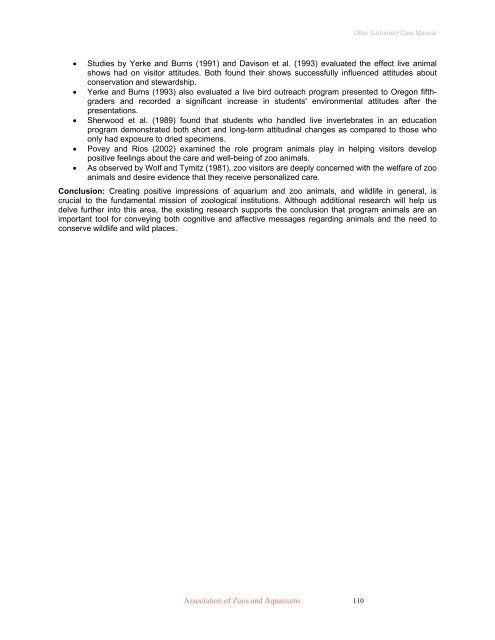Otter (Lutrinae) Care Manual - Association of Zoos and Aquariums
Otter (Lutrinae) Care Manual - Association of Zoos and Aquariums
Otter (Lutrinae) Care Manual - Association of Zoos and Aquariums
Create successful ePaper yourself
Turn your PDF publications into a flip-book with our unique Google optimized e-Paper software.
<strong>Association</strong> <strong>of</strong> <strong>Zoos</strong> <strong>and</strong> <strong>Aquariums</strong> 110<br />
<strong>Otter</strong> (<strong>Lutrinae</strong>) <strong>Care</strong> <strong>Manual</strong><br />
• Studies by Yerke <strong>and</strong> Burns (1991) <strong>and</strong> Davison et al. (1993) evaluated the effect live animal<br />
shows had on visitor attitudes. Both found their shows successfully influenced attitudes about<br />
conservation <strong>and</strong> stewardship.<br />
• Yerke <strong>and</strong> Burns (1993) also evaluated a live bird outreach program presented to Oregon fifthgraders<br />
<strong>and</strong> recorded a significant increase in students' environmental attitudes after the<br />
presentations.<br />
• Sherwood et al. (1989) found that students who h<strong>and</strong>led live invertebrates in an education<br />
program demonstrated both short <strong>and</strong> long-term attitudinal changes as compared to those who<br />
only had exposure to dried specimens.<br />
• Povey <strong>and</strong> Rios (2002) examined the role program animals play in helping visitors develop<br />
positive feelings about the care <strong>and</strong> well-being <strong>of</strong> zoo animals.<br />
• As observed by Wolf <strong>and</strong> Tymitz (1981), zoo visitors are deeply concerned with the welfare <strong>of</strong> zoo<br />
animals <strong>and</strong> desire evidence that they receive personalized care.<br />
Conclusion: Creating positive impressions <strong>of</strong> aquarium <strong>and</strong> zoo animals, <strong>and</strong> wildlife in general, is<br />
crucial to the fundamental mission <strong>of</strong> zoological institutions. Although additional research will help us<br />
delve further into this area, the existing research supports the conclusion that program animals are an<br />
important tool for conveying both cognitive <strong>and</strong> affective messages regarding animals <strong>and</strong> the need to<br />
conserve wildlife <strong>and</strong> wild places.









